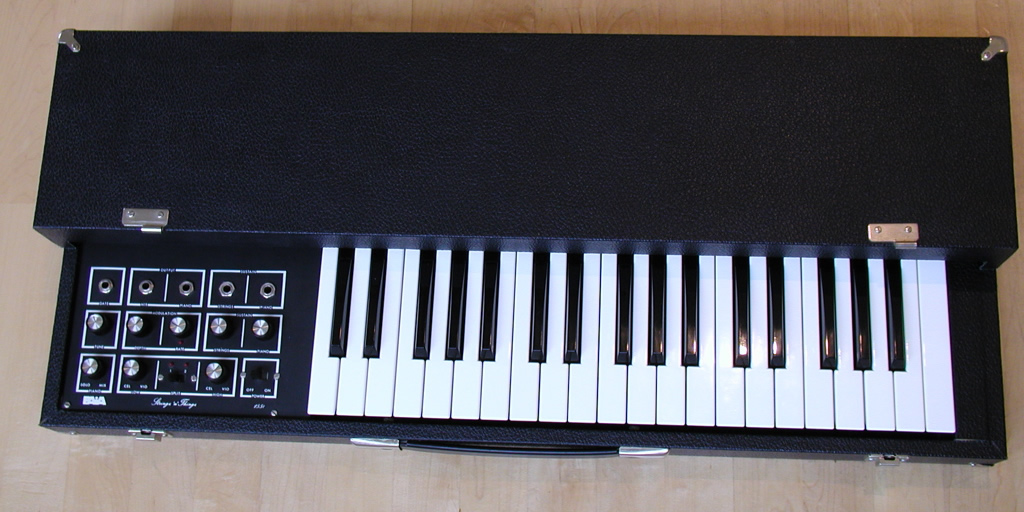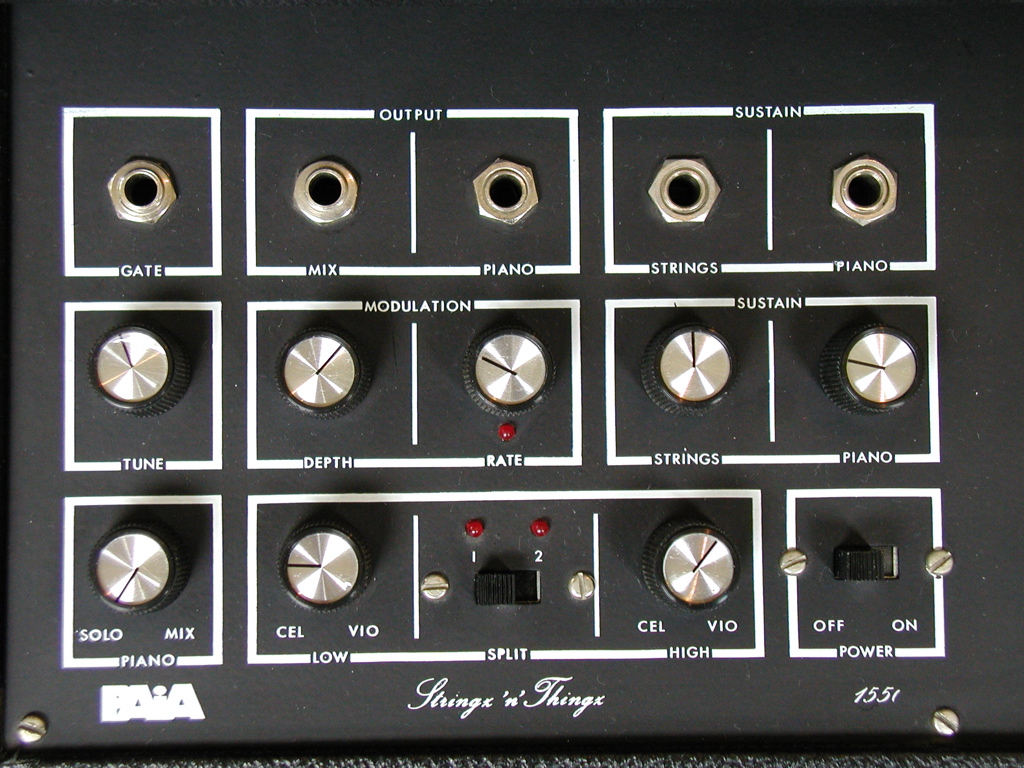

Stringz 'n' Thingz was designed in the 1977 time frame, and released in 1978. It was a synergistic result of my experimentation with analog delay lines, top octave generators, diode keying mechanisms, and my search for better string patches using the modular in the studio. I had experimented extensively with all the various analog delay lines as they were coming out in the mid-70s, and had recently completed the design of Paia's Phlanger and their analog delay line experimenters kit as a result of that work. After that, I worked with various arrangements of delay lines for multi-voiced chorusing, and out of that came the 3 voice chorus circuit which was used in Stringz.
John and I had both been working with top octave generators, and wanted to find unique uses for them, beyond the obvious basic combo organ applications. I had worked with synth keyboards most of my life, and had never been very attracted to combo organs anyway. But I had always been curious about how diode keying mechanisms worked in larger more complex organs. I had seen organs which offered some simple attack and sustain ('release' in synth terminology) parameters, so I realized that type of operation of diode keying was a possibility even though most combo organs were using simple switched square waves for keying. So I dug into basic diode keying, then figured out how to stage the impedances through the keying circuit to allow for variations in charge flow during the keying action. I was actually pretty surprised how much range of attack and release control was possible, and was surprised the organ manufacturers didn't utilize that range. So, out of that came the keying circuit with bussed master control voltages, and simultaneous use of parallel keying impedance paths for use with multiple voicings from one key closure action.
In early days of modular synthesis, many people were working with simulating the more complex instruments through synthesis ... specifically voice, piano, and strings. In an interview with Pat Gleeson in Keyboard magazine, he had talked about the fallacy of the stereotypical use of sawtooth waves for string generation. Most people were starting with sawtooths, based on the assumption that the bowed string physics is based on the bow pulling the string to the side and then releasing it, and repeating as the string was bowed. While that may have been an analog of the string motion, it failed to take account of the complex resonances of the violin body/bridge/soundpost operation. That's why Moog ended up designing several complex filter banks, culminating in their "String Filter" module. Pat was proposing that starting with narrow pulse widths in the 10% - 40% range was actually a better starting point for string synthesis, because the spread spectrum of the harmonics of narrow pulses better simulated the multiple resonances of violin bodies and systems. Thus it was easier to gang up a bunch of VCOs with some variable pulse widths going on, and circumvent all the complex filtering later in the processing. I experimented with that on the modular, and was in total agreement. Further, it became apparent that certain specific ranges of pulse widths lended themselves to simulating certain violin body sizes when used in certain ranges. Fatter pulse widths at lower frequencies for cello bodies, and narrower pulse widths at higher frequencies for violin/viola bodies.
John and I had both been studying the use of state machine design as the breadth of logic chips was developing, as it was obvious that state machine design was a natural for many music technology and user interface applications. So we had used plenty of 4000 series CMOS circuits in various products, and were well into boolean logic from our engineering education. So, as soon as I had seen the relationships of pulse widths to string voicings, and realizing that top octave generators were just big square wave generators, it was obvious that CMOS logic could be used to convert TOGs into narrow pulse width generators. Combining all the above technologies, this string synthesizer was born.
The second "piano" voicing was added as a complement to the soft attack string sound. It's actually more of a harpsichord type of sound. But helps Stringz cut through the mix a little better. And gives the instrument a little more versatility.
I added the keyboard split function to try to get more realistic sounds by having cellos separated from violins. So good keyboardists could properly perform orchestral counterpoint and chord voicings. Most of the early string synthesizers were not providing split keyboards, so violin and cello voicings just got mushed together as a "layer" rather than as a "split".
The multifunction sustain jacks can be used with either foot switches, volume pedals, or control voltage inputs for maximum versatility either in the studio or for simpler stage setups. I was always pushing for putting more things under remote or voltage control, and still look for maximum variability and external control for anything I use in the studio. So these multifunctional interfaces were something I had put on the Phlanger, and developed the idea a bit further for this machine.
Another function lacking from most string synths was a decent lush stereo output. You always had to run string synths through external chorusing or phasing to get the stereo field of motion effect. So, from the beginning, I had a plan for adding a second chorusing board to the Stringz which would allow stereo output as a design function. Due to the expense of the delay lines, we made the stereo output optional as the 1551 kit. Unfortunately, most users didn't install the 1551, so most Stringz still existing out there today don't have that option. But it allowed 2 output modes. One created a stereo field from the split switch on the front panel. The other sent cellos to one side and violins to the other (without loss of control of the front panel blend control). All in all, a very flexible stereo generating arrangement, and still my favorite mode of operation for Stringz.
Below is the front panel of Stringz, showing some of these features:

At the time Stringz was put into production, it was the largest kit ever produced by Paia. The circuit boards were larger. And there were more of them. And the parts count was huge. But many of them were low cost devices like signal diodes and CMOS logic chips, so the price didn't skyrocket as a result. And this was one of the first products to be made available assembled, because we knew many music stores and musicians would be interested in such a product. From that point onward, Paia started offering more of their products assembled, because Stringz drew attention from music stores worldwide. This was also the first product to use the larger 8 X 11 manual format, right after Paia bought the new larger printing press.
So, I feel honored that so many paradigms were broken for Paia through the release of Stringz.
PDFs of the 1550 and 1551 Users Manuals are available in my Paia Documents archive here.
The Radio Electronics cover feature for Stringz is available in my Publications archive here.
A simple demo of the 1550 while working the controls is here. (MP3 - 3 Meg)
A couple of great hacker sites with Stringz related mods and expansions -
MarkW in St. Louis built a combined Stringz and Organtua with common keying - here
Stefan Vorkoetter in Canada built an expanded Stringz with 44 notes, flute voices, and more processing - here
2/22/10
.